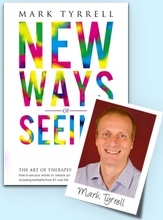
The therapeutic alliance is the keystone in effective therapy
Could a robot do therapy? Or a computer?
Well, maybe. To some extent.
A robot doesn’t judge you. A robot may be a good listener. If that’s what it’s been programmed to do, it might very ably feed back what you say.
And perhaps it could be engineered to set you therapeutic tasks; help you spot and challenge absolutist and depressive thinking styles, which after all are binary; and even use soothing language and tone to provide deep relaxation, such a vital part of therapeutic treatment.
There is even evidence that computerized cognitive behavioural therapy (CBT) can be effective for depressed and anxious young people,1 and I have found that even severely depressed people find great value in our self-service online depression treatment program, although I do interact with participants to some extent if they want me to.
So what might be missing from this?
Prefer to watch instead?
A real, human alliance
Relationships matter. The warm, breathing, beating heart of two humans coming together for a common purpose is not one that is easily automated.
When it works well there is something unique and irreplaceable about the warm and secure relationship that aids the therapeutic process. In life generally, supportive relationships help us feel secure, strong, valued, and inspired. And the therapeutic alliance, is of course, no different – except that the client’s needs come far above those of the therapist, who is, after all, being paid.
The therapeutic alliance is a base from which therapy can happen.2 And in order for that base to develop, we need to be a certain way for our clients.
The therapist needs to seem and be credible, able, and confident, but also human and humane for their clients. Rapport can be established quickly and easily with most people. Yes, of course they need to be willing and able to work with us. And we need to be interested in the client’s lives, ideas, and strengths and resources. But we have to be very mindful of something else too.
Therapeutic alliance, not reliance
There is no doubt that the alliance between client and therapist, its warmth and trust, contributes greatly towards positive therapeutic outcomes (along with actual aptitude and knowledge on the part of the therapist and readiness in the client, obviously).
I have written before about the therapeutic relationship and how vital it is that the therapist be aware that any primal emotional needs their client may be meeting from the therapy will ultimately need to be met by the client’s wider life.
In other words, if the client (or indeed the therapist) is meeting their needs for attention, intimacy, or meaning only from therapy then the potential autonomy and emotional health of the client is compromised until those needs are met away from the therapeutic situation. All therapists need to be clear about this.
Here I want to offer three elements that I have found help strengthen the therapeutic alliance.
1. Emphasize the therapeutic alliance in the way you speak
I recall a client asking me, “Well what are you going to do?” He’d sat down and simply said, “Go on then, do your stuff!” I had laughed and said that even when you go for a massage you have to do something – lie down, maybe remove your shirt, and so on. It wasn’t a question of just me doing something but both of us working together.
In romantic relationships it’s been found that when partners use the pronouns ‘we’ and ‘us’ more often, what the researchers called “we-talk”, the relationship tends to be stronger, naturally happier, and more resilient.3
The language used conveys that truth, but I suspect purposefully using we-talk more can, in return, also help strengthen the relationship. Indeed, the researchers conjected that hearing your partner use we-talk can help you feel better about the relationship as a whole.
Perhaps all of us in the world need to think and talk more in terms of ‘we’ and ‘us’ rather than separateness and division. But I digress.
Anyway, we can use alliance-building we-talk in therapy to convey the reality that we are a team of two.
- “As we leave depression behind we’ll start to see that you have more energy in the mornings and actually start to feel like doing the kinds of things you know are good for you.”
- “We’re going to work together to help comfortably lift that trauma so you no longer feel troubled by flashbacks or nightmares. That’s what we’re looking for here.”
- “As we work together we’ll look at causes but also solutions to help you to start feeling better quickly.”
So we can use our language to position therapy as a ‘we‘ activity, not a ‘me separate from you’ process. We don’t do therapy to our clients but rather with them. We are facilitators as much as directors.
But I also like to give the client credit when they make progress. Because after all, it’s them that makes the changes ultimately, even if it’s us that helps them do that.
Linked to this is my next point. As much as anything else, therapy is a process of discovery.
2. Remember that therapy is a learning situation
Therapy is a learning process. But you are both the student and the teacher. You may know how to lift trauma fast, work with addictions, and spot and challenge depressive thinking styles, but the alliance we have with our clients means we don’t just apply our knowledge with them randomly.
Clients lead us by what they say and experience, and from that we need to then learn just what aspects of our knowledge they need, when, and perhaps how. When we ask therapeutic questions we are doing so in order to truly learn, but also help our clients learn, from those questions.
The art of Socratic questioning used by therapists is as much about the client teaching the therapist as it is about the client teaching themselves.
When we ask someone a question like “Is it possible for a generally decent person to behave badly sometimes?” or “Can a person come back from losing a business and still make a success of their future life?” we do so in the spirit of genuinely wanting to learn from the client rather than trying to force a ‘right’ answer upon them.
When context perception is widened in the client it is also widened in the therapist. We see more together.
Lastly, we need to convey to our clients that we are confident not just in ourselves but, more importantly, in them.
3. Heighten expectation through your confidence
“I am very confident. I look confident. I act confident. I speak in a confident way.”
– Milton H. Erickson
Dr Milton Erickson also said, “The most important thing in changing human behaviour is the person’s motivation.” And for motivation we might just as well say expectation.
But we don’t have to just sit back passively and simply hope and pray our clients will be motivated to change. We can help them build that expectation by conveying our confidence in them simply by the way we behave.
We can talk to them not just about how they are or have been, but how they need and want to be in the future. We can help them believe they can grow and change with every nuance of every word and every gesture we use to communicate with them.
We can use presuppositions and talk about ‘as’ and ‘when’ they change rather than ‘if’. We can ask questions that presuppose change, such as “Who will be the first person to notice without you telling them that you have started to leave that depression behind? And what will they notice about you, do you suppose?”
We can ourselves strongly envisage our client already having made necessary changes so that we too feel congruent in communicating our confidence about them to them.
There are few things you can do for someone greater than believing in them. And, in doing so, helping them believe in them too. Not just as they are but as they will be.
Robots may replace many jobs, but the living, breathing heart of shared human experience – and the intuitive flashes sparked from such interactions – is one that will never be completely mechanized.
Helping a UPTV client overcome health-related anxiety
This client’s mother died thirty years before at the age of 59 from cancer. Her father had cancer although he died from heart failure. She lost two brothers-in-law over the past three years, both in their forties, to cancer. Now any mention of a symptom can make her feel highly anxious. These symptoms have got worse over time. She also has quite high generalized stress levels.
Members of Uncommon Practitioners TV can watch this session now, and if you’re not yet a member, you can sign up here to be notified when UPTV is open for booking.
Notes:
(1) https://journals.plos.org/plosone/article?id=10.1371/journal.pone.0119895
(2) https://focus.psychiatryonline.org/doi/abs/10.1176/foc.4.2.269
(3) http://journals.sagepub.com/doi/10.1177/0265407518795336






